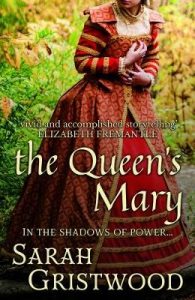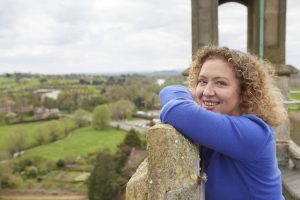I am delighted to host this guest article by Sarah Gristwood, to celebrate the UK publication of ‘The Queen’s Mary: In the Shadows of Power’ on 4th September by Endeavour Press.

You can buy it from:
Thank you to Sarah for this article.
The Four Marys
When the five year old Mary Queen of Scots set sail for her new life in France, where she was to be raised as bride to the French Dauphin, four other little girls set sail with her. All four were also called Mary, after the Virgin, and we’ve all heard them mentioned in a favourite nursery rhyme.
How does your garden grow?
With silver bells,and cockle shells
And pretty maids all in a row.
‘Mary’ is the queen, the silver bells those that ring out in church, and cockle shells the emblem of the Catholic pilgrim. The pretty maids are the famous Four Marys (or Maries).
Mary Beaton, Mary Seton, Mary Fleming and Mary Livingstone all came from leading Scottish families. Mary Fleming’s mother Lady Fleming (who also accompanied the little Queen to France) was, indeed, the illegitimate daughter of King James IV, which gave Fleming a kind of pre-eminence . . . as later would her beauty. But we have only snatches of information about the actual personalities of the Marys. We know, for example, that Livingstone was known as ‘the lusty’ – and that Beaton was surely scholarly, since the Queen at one point planned to leave her half her Greek and Latin books.
Raised first in a convent at Poissy and then at the French court, in 1561 all four Marys returned to Scotland with the widowed Queen of Scots. Over the next few years at court, glimpses of them can be seen in ambassadors reports. Dressed in black and white at a Shrovetide celebration, when Fleming took the starring role as Queen of the Bean; dressing up as men along with their mistress on one occasion; sallying out with her disguised as burgesses’ wives on another. But behind these glimpses of them at the Queen’s side, they each had of course their own stories.
One by one three of the four married. Mary Livingstone, Livy, married first. Her bridegroom was John Semphill, a mere younger son, but one whose family were loyal supporters of the Queen. This was probably a love match but Queen Mary signed the contract on 3 March 1565, giving a substantial dowry and paying for the wedding feast, the wedding gown, and indeed the scarlet velvet wedding bed. The son Livy bore her husband was brought up with Prince James, and later served him faithfully. (That is in itself an oddity, since the Queen’s Marys were naturally Catholic like she, while Prince James was reared in strict Protestant faith. Had Livy bowed to the prevailing religion?) She would die in 1585 – comparatively early.
Mary Beaton is said to have been romantically involved with the English ambassador Thomas Randolph. There is a record of Beaton and Randolph playing billiards against Queen Mary and Darnley. But in spring 1566 she was married to Alexander Ogilvy of Boyne – a man in love with another woman. (That other woman, Jean Gordon, had just been married off to Lord Bothwell, in a match also made by Queen Mary.)
Did Beaton resent being used like a pawn on a chessboard? It is one of those points in history when one would love to know – and the novelist can imagine – the emotions that lie behind the recorded story. Beaton bore children, but it was said her marriage was unhappy, and after she died in 1597 her husband made haste to marry Jean Gordon, his old love.
Antonia Fraser in her classic biography Mary Queen of Scots records an old suggestion that Beaton (whose handwriting was said to resemble the Queen’s) wrote the ‘Casket Letters’ – the documents that have been used to damn Queen Mary through the ages. There is, as Fraser points out, no evidence for this; and as far as the actual work of forgery is concerned, a more prosaic explanation seems more likely. But in my new novel The Queen’s Mary I took this theory and ran with it . . . though any possible revenge against the Queen on Beaton’s part I have envisaged rather differently!
Mary Fleming was the last to marry, though hers had been the longest-lasting love story. Not long after the return to Scotland she was courted, improbably, by the Queen’s state secretary William Maitland, the so-called ‘Scottish Machiavelli’, a widower at least fifteen years older than she.
There was no speedy wedding. It seems possible the Queen used Fleming to control Maitland, just as she used Beaton to manage Randolph. The English ambassador wrote that Maitland would support Queen Mary’s marriage to Darnley ‘from the love he bears to Mary Fleming’. They were finally married on 6 January 1567, only months before Queen Mary’s downfall. The groom’s old friend Kirkaldy of Grange said she was as suitable to be his wife ‘as I am to be Pope’ – but the match was personally happy though beset by tragedy.
In the last months of Mary’s reign, Maitland sided with the rebel Lords against the Queen. Yet while she was held captive on Lochleven he sent her a jewel – depicting a lion in a net gnawed free by a mouse – which bore the tacit promise of renewed loyalty. Fleming’s influence, maybe? Maitland supported the Lords when an enquiry was held at York into Queen Mary’s conduct, but in Scotland’s continuing turmoils he then sided with her supporters, joining his old friend Kirkaldy of Grange who was holding Edinburgh Castle for her.
But Maitland was by that time seriously ill, immobilised by a wasting disease, and his wife quit the peace of Lethington Tower, where she had been raising their two children, to join and nurse him. When Edinburgh Castle was taken in 1573 he was taken prisoner and died in captivity, perhaps by his own hand, and Fleming had to fight for the right to bury his body. She married again, however, and probably died around 1600.
And what of the fourth Mary, Mary Seton? Well – she is my heroine in The Queen’s Mary! She barely features in any reports of the Scottish years, yet the only certain image that survives of any of the Marys is a famous illustration of the Battle of Carberry – the battle at which the Queen effectively lost her crown – which shows the tiny stick figure of Seton riding right behind Queen Mary. Because Seton was the only one of the four Marys who stayed, who would follow her mistress into English captivity.
It was Seton, indeed, who made possible the Queen to escape from Lochleven. Tall as the Queen herself, she dressed in her mistress’s black gown and remained on Lochleven to fool the guards while Queen was rowed away dressed in a servant’s red kirtle. Some months after the Queen fled over the border into England, Seton was allowed to follow her mistress, and the Queen’s gaolers noted that Seton was especially able at dressing the royal hair, ;’without any cost, and yet setteth forth a woman gaily well’.
In the late 1560s she was courted by one Christopher Norton, younger son of an English gentleman, whom she met at Bolton Castle, the Queen’s first place of imprisonment. But in 1569 Norton, joining the revolt of the Northern Earls which aimed to put Queen Mary on England’s throne, was captured and executed at Tyburn.
The following year Seton fell ill, but in the 1570s another man sought to marry her. This was Andrew Beaton, who had just succeeded his brother John as Master of the Queen’s Household. Touching letters concern gifts for Seton – a silk hanging, a watch the queen wanted as a present for her – and suggest he loved her.
Queen Mary favoured a match which would ally two great families among her supporters, and worked hard to bring it about. As late as 1577 she was writing to Andrew’s other brother, the Archbishop of Glasgow and the Queen’s representative in Paris, that she had spoken three times to ‘our girl’.
But a reluctant Seton claimed that Beaton was below her in rank – and that she had taken a vow of chastity. Finally she was brought to agree that she would marry him if the vow could be set aside, and Beaton left for Paris, probably to consult the authorities at the Sorbonne. He died of smallpox on the way home. In 1583 – fifteen years after they first arrived in England – Seton left the Queen’s service on the grounds of ill health and was allowed to retire to France, entering the convent of Saint Pierre-les-Dames in Rheims, where Queen Mary’s aunt Renee de Guise was abbess. She would outlive her queen by more than a quarter of a century.
In 1613 she was visited at Rheims by James Maitland, Fleming’s son, who Fleming had raised as Catholic. Maitland described Seton then as being ‘decrepit and in want’, but two years earlier, in 1611, she had been well enough to write a lengthy letter to a contact in England – a request for help in trying to get some sort of pension from King James.
The letter is still preserved in the archives in Longleat. I stumbled upon it there, while researching the life of the Scots Queen’s niece Arbella Stuart – the first, perhaps, to take notice of it for years. It was that evidence of a life lived beyond the queen’s shadow which gave me the urge to write Mary Seton’s story.
More than three hundred year after Seton’s death in 1615 or shortly after, in her landmark essay A Room of One’s Own, Virginia Woolf gives the names Mary Beton [sic] and Mary Seton to two of her characters. Woolf’s Beton and Seton are found at an Oxbridge college, illustrating at once the difficulties women faced in getting, for example, an education – and their efforts to overcome them. The degree to which women have been marginalised in the narratives of men . . . and their determination finally to tell their own stories.
Telling the story of the women who scarcely feature in the records? Who were involved in great times and great events, but whose feelings were not recorded for posterity? You might say that is where I tried to come in, when I set out to write The Queen’s Mary.

Follow Sarah on Social Media:
Sarah’s website: Sarah Gristwood
Twitter: @sarahgristwood




































